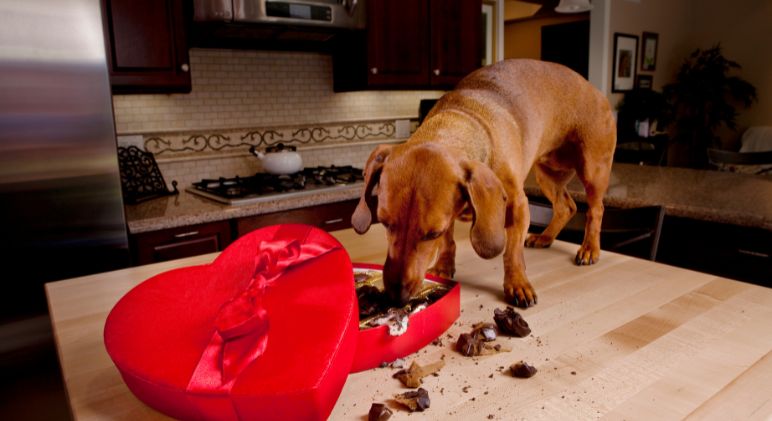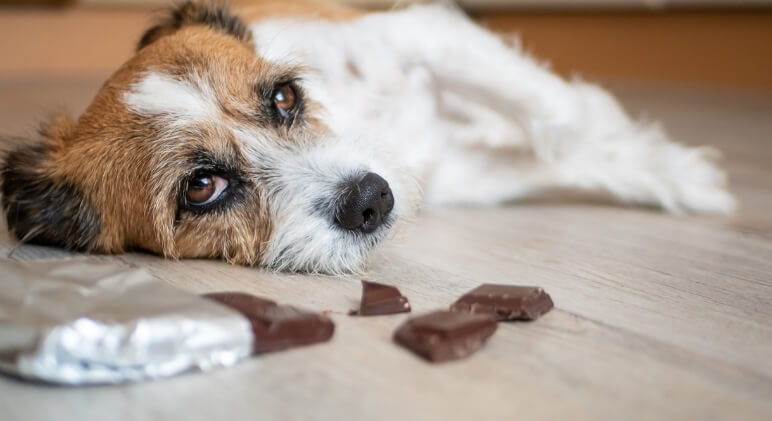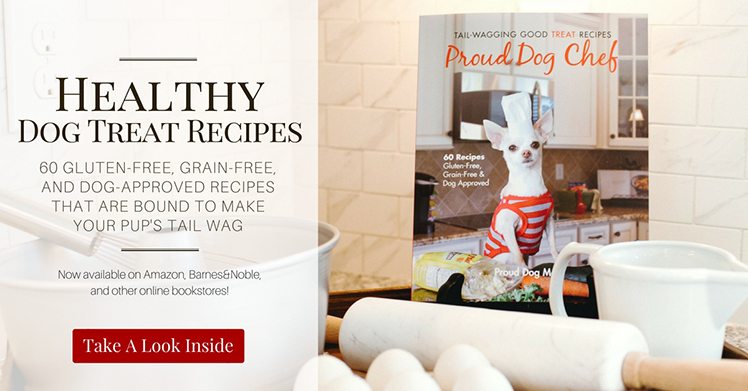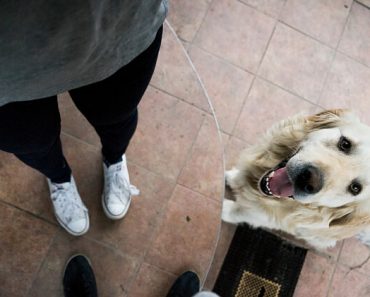Most dog parents know chocolate is a no-go for their canine companions. Yet, if you spot an educational social media post on the topic, you’ll undoubtedly see comment after comment saying, “My dog ate chocolate once and was fine.” To take things one step further, I recently saw a TikTok video, where a group of people fed their dog a Hershey’s bar … just to see what happens. I must admit, that video infuriated me. Here’s the deal: Chocolate is toxic to dogs.
Why is Chocolate Bad for Dogs?
Chocolate contains caffeine, as well as a chemical called theobromine (AKA a cousin chemical to caffeine). Our dogs can’t metabolize these compounds as well as people can, making them much more sensitive to effects.

Symptoms & Signs of Chocolate Poisoning
According to veterinary experts, chocolate is rarely fatal to dogs. However, depending on the type and amount eaten, it can cause:
- Vomiting
- Diarrhea
- Increased thirst
- Excessive urination
- Panting
- Restlessness
- Racing heart rate
In severe cases, symptoms can also include muscle tremors, seizures, and heart failure.
Chocolate toxicity symptoms usually occur between 4-24 hours after your dog has eaten chocolate.
So, How Much Chocolate is Actually Toxic to Dogs?
This is the question every dog parent asks when talking about chocolate. It’s true: Dogs who accidentally eat one or two M&Ms or a chocolate chip that falls on the floor are unlikely to develop chocolate poisoning. But, when it comes to toxicity levels, they vary depending on a few factors.
- Type of chocolate – The amount of toxic theobromine varies with the type of chocolate. As a general rule of thumb: The darker and more bitter the chocolate, the more dangerous it is to dogs. Ranking from worst: Dry cocoa powder, baker’s chocolate, dark chocolate, semi-sweet chocolate, and milk chocolate. *A little about white chocolate below.
- Amount of chocolate
- Size of your dog
Let’s put this all into perspective. According to VCA Animal Hospitals, “A medium-sized dog weighing 50 pounds would only need to eat 1 ounce of baker’s chocolate, or 9 ounces of milk chocolate, to potentially show signs of poisoning.”

What About White Chocolate?
According to the Pet Poison Helpline, “White chocolate has very little theobromine and will not cause chocolate poisoning in pets.” However, pet parents are still urged to keep white chocolate away from their furry family members. That’s because it may contain other ingredients — like cocoa butter, sugar, butterfat, and milk solids — that can lead to tummy upset and even pancreatitis in dogs.
Find out more about pancreatitis in dogs HERE.
Tool to Try: Online Chocolate Toxicity Calculators
I personally have two small dogs (one is 6 lbs, the other is 8 lbs). Plus, when I buy chocolate, I usually opt for dark. So, I’m incredibly careful where I leave my snacks lying around. To help you get a better understanding of how various chocolates may impact your precious pooch, check out THIS interactive Chocolate Toxicity Calculator by VetsNow. It’s a useful guide.

What to Do if Your Dog Has Eaten Chocolate
If you suspect your dog has eaten chocolate, call your veterinarian immediately. Give them as many details as possible: What type of chocolate your dog consumed (keep the packaging, if possible) and how much you believe your dog has eaten. Plus, while it’s in their file, remind your vet how much your dog weighs.
If your vet’s office is closed, you can either call a local emergency veterinarian or the Pet Poison Helpline (855) 764-7661. The Pet Poison Helpline is available 24/7, 365 days a year. A $75 incident fee applies.
Depending on the severity, your vet may induce vomiting, administer activated charcoal, and/or offer IV fluids. For more serious cases, Pet Poison Helpline states dogs may also need “sedatives to calm the pet, specific heart medications to reduce the heart rate and blood pressure, anti-convulsants for seizures, antacids (such as Pepcid) for stomach discomfort and diarrhea. Theobromine may be reabsorbed across the bladder wall so a urinary catheter or frequent walks are needed to keep the bladder empty.”
What About Those Fancy Dog Bakeries that Sell Chocolate Dog Treats?
Have you ever noticed a chocolate-looking icing on gourmet dog biscuits? Or perhaps pup cakes that look like they’re filled with chocolate chips? Well, there’s no need to worry because that isn’t actually chocolate. It’s carob … which is super tasty and totally safe for your dog.
While chocolate comes from cocoa beans, carob chips are made from the pod of a carob tree. Inside the pod is sweet pulp that is dried, roasted, and ground into a powder. You’ll find both carob powder and carob chips in the store. It’s naturally sweet and tends to have a nuttier flavor than chocolate.
Find out how to make your own carob icing for dog treats HERE!

A Word to Pet Parents
While animal poison control centers report an increase of chocolate calls during holidays – like Easter and Halloween – they do receive calls daily.
I know a lot of pet parents question how toxic chocolate really is, as they say their dogs have eaten it before without getting sick. To summarize, toxicity is all about the type and the amount consumed. Remember: Even small amounts of the darkest chocolates can be dangerous. I urge you to keep chocolate away from your pups at all times. It’s not worth the risk! Don’t leave chocolate in areas your dog can reach, like countertops, tables, desks, and nightstands. Instead, make sure all chocolate is kept in the pantry or a closed cabinet, and up on a tall shelf.
Sources
Pet Poison Helpline
VCA Animal Hospitals
VetsNow
More Foods Dogs Should Avoid
Along with chocolate, there are other “human foods” we should keep away from our four-legged family members. Check out THIS extensive list of yes/no foods for dogs.








